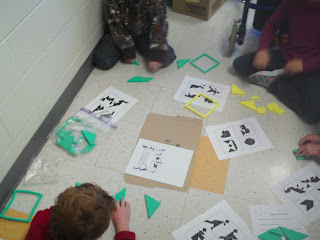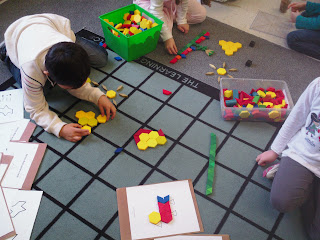This is how a group of students began their work in response to the question 'Do you know anyone who has lived 1000 days?' As they are eight years old, they decided to see if they are 1000 days old by checking 8 times 365. Notice how they just write down the 5 and 6 digits in the solution as "there is nothing above them". They then do eight times 'three' to get 32.
Now these are grade 3 students so they are only just beginning to learn about multiplication and should not be coming across any formal algorithm until Grade 4 at the earliest. But when it does come to the time for them to learn how to compute something like this, I am certain that they will be more succesful by being introduced to the array method first.
The neat thing was that even though they got the calculation wrong, they knew that 8 years was way above 1000 days. So they then tried 6 years, then 5 years, then 4 years and finally 3 years. Each time, the calculation was incorrect but their reasoning based on this calculation was perfect. Not bad for Grade 3!
A Math(s) teacher from Yorkshire, now working in Ontario and always learning about how students best learn Math(s).
Thursday, November 24, 2011
Geometry Centres
 I took part in a really engaging geometry lesson in a Grade 1/2 split this week. Five centres have been set up and the students work pretty much independently on these; you can see them building their own geometry knowledge as they do the activities. The talk that these activities provoked was impressive and exciting as the students focussed on the geometric properties and relationships.
I took part in a really engaging geometry lesson in a Grade 1/2 split this week. Five centres have been set up and the students work pretty much independently on these; you can see them building their own geometry knowledge as they do the activities. The talk that these activities provoked was impressive and exciting as the students focussed on the geometric properties and relationships.
 Compare this approach to the worksheet approach where kids just write the word square next to a picture of a square. Or even worse, cube next to a 2D picture of a cube: how can anyone truly learn about three-dimensions from a two-dimensional worksheet?
Compare this approach to the worksheet approach where kids just write the word square next to a picture of a square. Or even worse, cube next to a 2D picture of a cube: how can anyone truly learn about three-dimensions from a two-dimensional worksheet?
The students' use of Mathematical Processes were in abundance including a surprising amount of reasoning and proving ("I think I'll need four sticks to make a cube and I'll show you") and reflecting ("Oh, I needed 12 sticks because a cube is not a square.")
Even a simple question such as 'Use the two larger triangles (from a set of tangrams) to make different shapes' brought out a wealth of geometric ideas e.g. composing and decomposing shapes, names of different shapes, congruence. The tactile component here was a vital part of the learning: kids need to flip, rotate and move shapes to learn about them.
After all, if the world's best geometer, Donald Coxeter, used manipulatives and concrete materials to help him better understand geometry, then why shouldn't all our students do so?
You don't learn geometry from a blackline master.
Subscribe to:
Comments (Atom)
